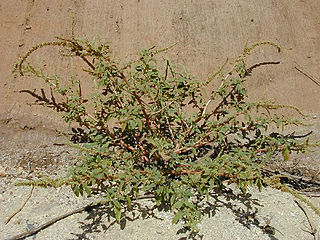
Basella alba is an edible perennial vine in the family Basellaceae. It is found in tropical Asia and Africa where it is widely used as a leaf vegetable. It is native to the Indian subcontinent, Southeast Asia and New Guinea. It is naturalized in China, tropical Africa, Brazil, Belize, Colombia, Philippines, the West Indies, Fiji and French Polynesia.

Amaranthus blitum, commonly called purple amaranth or Guernsey pigweed, is an annual plant species in the economically important plant family Amaranthaceae.

Guizotia abyssinica is an erect, stout, branched annual herb, grown for its edible oil and seed. Its cultivation originated in the Eritrean and Ethiopian highlands, and has spread to other parts of Ethiopia. Common names include noog/nug ; niger, nyger, or nyjer seed ; ramtil or ramtilla; inga seed; and blackseed.

Crassocephalum rubens, also called Yoruba bologi, is an erect annual herb growing up to 80 cm tall. It is grown and consumed especially in Southwestern Nigeria, but also as far away as Yemen, South Africa, and islands of the Indian Ocean. Its mucilaginous leaves are used as a dry or fresh vegetable in a variety of dishes, and as medicine for several different ailments.

Amaranthus viridis is a cosmopolitan species in the botanical family Amaranthaceae and is commonly known as slender amaranth or green amaranth.

Amaranthus spinosus, commonly known as the spiny amaranth, spiny pigweed, prickly amaranth or thorny amaranth, is a plant that is native to the tropical Americas, but is present on most continents as an introduced species and sometimes a noxious weed. It can be a serious weed of rice cultivation in Asia.

Amaranthus tricolor, known as edible amaranth, is a species of flowering plant in the genus Amaranthus, part of the family Amaranthaceae.
Amaranthus thunbergii, commonly known as Thunberg's amaranthus or Thunberg's pigweed, is found in Africa.

Amaranthus dubius, the red spinach, Chinese spinach,, spleen amaranth, hon-toi-moi, yin choy, hsien tsai, or Arai keerai is a plant species. It belongs to the economically important family Amaranthaceae.

Celosia trigyna is a plant species commonly known as woolflower for its curious flowers.

Plant Resources of Tropical Africa, known by its acronym PROTA, is a retired NGO and interdisciplinary documentation programme active between 2000 and 2013. PROTA produced a large database and various publications about Africa's useful plants.

Alepidea peduncularis is an edible perennial herb native to the montane grasslands of East and South Africa.

Barleria obtusa, the bush violet, is a species of flowering plant in the family Acanthaceae. It occurs naturally along forest margins in the summer rainfall region of South Africa. It is widely cultivated as a decorative garden shrub.

Astragalus atropilosulus is a perennial herb in the legume family. It is native to Africa.

Asystasia mysorensis is an edible plant species in the family Acanthaceae found in Africa. It is used as a leafy vegetable and for animal fodder.

Bidens pilosa is an annual species of herbaceous flowering plant in the daisy family Asteraceae. Its many common names include hitch hikers, black-jack, beggarticks, farmer’s friends and Spanish needle, but most commonly referred to as cobblers pegs. It is native to the Americas but is widely distributed as an introduced species in other regions worldwide including Eurasia, Africa, Australia, South America and the Pacific Islands. In Chishona, it is called tsine.

The plant genus Caylusea is a small group of plants found in parts of Africa and India. Caylusea abyssinica is eaten as a vegetable.

Alternanthera littoralis is an African species of plant in the family Amaranthaceae. The leaves are eaten as a vegetable.

The Sanetti Plateau is a major plateau of the Ethiopian Highlands, in the Oromia Region of Ethiopia. The plateau is the highest part of the Bale Mountains, and is located within Bale Mountains National Park.

Lippia abyssinica, or koseret, is a species of flowering plant in the verbena family, Verbenaceae. It is endemic to Ethiopia but cultivated throughout tropical African countries. The specific epithet abyssinica derives from Latin and means 'of or from Ethiopia (Abyssinia)'.


















